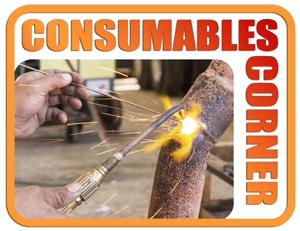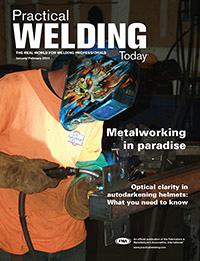Independent welding consumables professional
- FMA
- The Fabricator
- FABTECH
- Canadian Metalworking
Categories
- Additive Manufacturing
- Aluminum Welding
- Arc Welding
- Assembly and Joining
- Automation and Robotics
- Bending and Forming
- Consumables
- Cutting and Weld Prep
- Electric Vehicles
- En Español
- Finishing
- Hydroforming
- Laser Cutting
- Laser Welding
- Machining
- Manufacturing Software
- Materials Handling
- Metals/Materials
- Oxyfuel Cutting
- Plasma Cutting
- Power Tools
- Punching and Other Holemaking
- Roll Forming
- Safety
- Sawing
- Shearing
- Shop Management
- Testing and Measuring
- Tube and Pipe Fabrication
- Tube and Pipe Production
- Waterjet Cutting
Industry Directory
Webcasts
Podcasts
FAB 40
Advertise
Subscribe
Account Login
Search
Consumables Corner: Causes of centerline cracking in FCAW root passes
- By Nino Mascalco, Rob Koltz, and Steve Sigler
- January 20, 2015
- Article
- Consumables
Q: We are a bridge and structural steel manufacturing shop that uses a mixture of common base materials such as A36, A572, and A992. Recently we’ve been experiencing sporadic centerline cracks in the root passes of fabricated I-beams that we weld with flux-cored arc welding (FCAW). Oddly enough, there doesn’t appear to be a common variable causing the cracks. Can you provide some insight?
A: Centerline cracking in root passes isn’t all that uncommon. Often a combination of variables are responsible for cracking, so it’s important to identify which factor is most responsible and what other influences may attribute to it as well.
In your case, let’s start with some basic assessments. Do the cracks occur immediately after welding or sometime later on? How long have you been experiencing root cracking problems? Did this problem just start or has it always been more of a flare-up issue?
In most situations, cracking can be tied directly to a change in the manufacturing process. This can take the form of a change in material suppliers, base material issues, related welding variables, seasonal changes, welding personnel changes, or material handling methods. If you can tie any of these issues to when the cracking started, you may save yourself some time in determining the cause.
One common reason for root-pass cracking is welding on a highly constrained joint, which is done to minimize distortion and/or maintain dimensional tolerances. As the weld puddle solidifies, there is a definite amount of shrinkage. If the joined parts are unable to move or flex, the weld bead must endure all of this stress, which can lead to cracking.
Another reason for centerline cracking is attributed to improper bead shape, often the result of excessive weld joint gaps. If the welding parameters aren't quite optimum for the application, or the welder's technique is incorrect, the resulting weld bead could be shallow or have insufficient weld bead throat. When the weld puddle cools and solidifies, not enough weld metal is in the throat of the weld to absorb this shrinkage and the bead cracks down the middle. Both of these failures are known as a hot crack.
The third most common reason for centerline cracking is an insufficient amount of preheat for the joint. The insufficient preheat causes an accelerated cooling rate, which forms a brittle metallurgical structure called martensite. The weld’s failure mechanism is the same as described in the two other cases, although the cause is totally different.
Resolving centerline cracking can be as simple as adding or increasing the preheat temperature or slow-cooling the part. Other solutions include adjusting the welding parameters and improving joint fit-up to reduce or minimize gaps, which resolves the shallow throat in the center of the weld.
Keep in mind that any additional influences that are not ideal to the welding process could be compounded with others and cause cracking. It’s a good idea to review all manufacturing processes related directly or indirectly to the welding process and possibly tighten up the tolerances.
A good way to think of this is like reducing or minimizing tolerance stacking. More consistency in all processes leading up to, during, and after welding should greatly reduce the potential for this welding-related issue.
About the Authors


Rob Koltz
Application Engineer
411 S. Ebenezer Rd.
Florence, 29501
636-485-2253
Steve Sigler
Application Engineer
411 S. Ebenezer Rd.
Florence, South Carolina 29501
636-485-2253
About the Publication
Related Companies
subscribe now

The Welder, formerly known as Practical Welding Today, is a showcase of the real people who make the products we use and work with every day. This magazine has served the welding community in North America well for more than 20 years.
start your free subscription- Stay connected from anywhere

Easily access valuable industry resources now with full access to the digital edition of The Fabricator.

Easily access valuable industry resources now with full access to the digital edition of The Welder.

Easily access valuable industry resources now with full access to the digital edition of The Tube and Pipe Journal.
- Podcasting
- Podcast:
- The Fabricator Podcast
- Published:
- 04/16/2024
- Running Time:
- 63:29
In this episode of The Fabricator Podcast, Caleb Chamberlain, co-founder and CEO of OSH Cut, discusses his company’s...
- Industry Events
16th Annual Safety Conference
- April 30 - May 1, 2024
- Elgin,
Pipe and Tube Conference
- May 21 - 22, 2024
- Omaha, NE
World-Class Roll Forming Workshop
- June 5 - 6, 2024
- Louisville, KY
Advanced Laser Application Workshop
- June 25 - 27, 2024
- Novi, MI
































